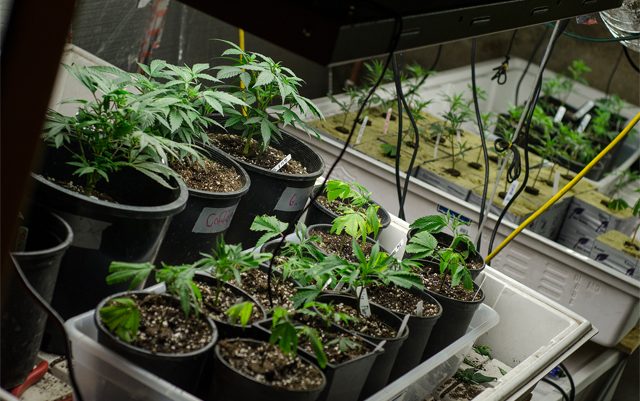I want to share a simple truth with you guys. Ready? Organic soil is only as complicated as you make it. For some of you, that’s an open invitation to build the most complex batch of soil with the widest variety of amendments you can get your hands on. If that’s you, charge on friend; I’m certainly not knocking it. There’s plenty of recipes out there for “supersoils”. If you have your own, pass on the knowledge in the comments!
But the rest of you just want something simple. Maybe you’re on a budget. Maybe you chose to grow in soil for simplicity. Or, maybe you just prefer things in life be as straightforward as possible. Whatever your reason, I can help you out.
Base Soil
Your base soil is going to be made up of the following:
- Sphagnum Peat Moss or Coco Coir
- An Aeration Amendment
- Humus
Alright so let’s get into each of these a little bit more.
Peat Moss or Coco Coir
We can go back and forth all day on whether you should choose peat or coir. I’ll eventually write a thorough comparison for you guys but for now I’ll just say that you’re fine with either option. If one is easier for you to get than the other, by all means go with that.
Just remember that peat moss is acidic. You’ll have to add some dolomite lime to your soil mix to help balance that out. It’s also a good idea to rinse your coco coir before using it to flush out any remaining salt buildup. Even if you bought a bag that claims to be “pre-rinsed,” rinse it again just to be safe.
Have both available and you’re just dying for my opinion? Go with the coco coir.
Aeration Amendment
An aeration amendment is exactly what is sounds like. It aerates and loosens up the soil. Without this component your soil won’t drain properly, your roots will suffocate, the microbe activity will drop from lack of oxygen, and you won’t be happy with your results.
Aeration amendments are things like perlite, pumice and rice hulls. If you can get your hands on pumice and/or rice hulls, I highly recommend going that route. Perlite is usually the easier product to find though. Since we’re going for organic, don’t use Miracle Gro products or anything else that includes a slow release fertilizer. Honestly, just do yourself a favor and avoid Miracle Gro products all together! I won’t get into it now, but they’re pretty awful.
You really only need one of these aeration amendments. But if you’re feeling adventurous, go ahead and use a combination. When it comes to organic soil, diversity is never a bad thing!
Humus
Humus, like compost or earthworm casting (EWC), not the delicious addition to pita chips. That one is spelled with two m’s like so, hummus.
I can’t stress enough the importance of using a quality compost. It is literally the driving force of your organic soil. Seriously, you can stop here and have a successful grow if you’re using good enough compost.
Ideally, you have a fine, aged pile of compost out back and an earthworm composting bin running full bore inside. Homemade humus is going to be leaps and bounds ahead of the store bought variety in terms of quality. If you don’t, or aren’t able to compost, don’t worry there’s a couple things you can try.
The first thing you can do is start asking and searching around. You’d be surprised how many people you can get in touch with that will gladly share from their compost bin. Social media, Craigslist, or even your local farmer’s markets are all great places to put out your feelers. I also feel compelled to tell you that an earthworm compost bin is easy and cheap to get started. More importantly, the quality of humus you get from one of these things is nothing short of phenomenal. Let me know if you’re interested in this in the comments and I’ll walk you through putting one together.
Worst case scenario is that you can’t find a source of homemade compost or castings. Don’t sweat it, all is not lost. I would just buy the highest quality (a little research never killed anybody) of both that you can find. If you can only afford one, go with earthworm castings.
Mixing Your Soil
Now we’re going to mix up 1 cubic foot of base soil. How do you measure that out? By using a precisely tuned instrument commonly referred to as a 5 gallon bucket. One cubic foot is equal to 7.5 gallons. For the recipe that follows, 1 part is 1 bucket full. Got it? Cool, let’s continue.
- ½ part peat moss or coco coir
- ½ part aeration amendment
- ½ part humus
Note: If you’re using peat moss, add a cup of dolomite lime to the mix to help balance the pH.
That’s it! Thoroughly mix your ingredients together and you have 1 cubic foot of base soil. It’s possible to stop here and still have a successful grow. Like I said before, that is largely dependent on the humus you were able to find. At the very least though you can use this base mix to start seedlings and clones.
But let’s say you aren’t too confident in the quality of your humus or you’re looking to take it a little further. What now?
Amendments and Additives
There is a long list of soil amendments and additives to choose from. I know when I first got into organic gardening I was a bit overwhelmed. I promised to keep this simple for you so I’m going to lay out the 4 products I believe you should invest in first. Listed in order of importance, they are:
- Rock dust
- Aerated compost tea
- Kelp Meal
- Alfalfa Meal
Rock Dust
Soil at its most basic, and remember this can be as complicated as you make it, is just a combination of shattered rock and composted organic material. So really, to have a proper soil we must add rock dust. But what kind? Azomite or glacial rock dust are great options that can be found in most nurseries or even online. If you’re tight on cash, poke around for some granite rock dust. It’s usually fairly cheap and works quite well.
By adding rock dust to your mix you’re not only providing an additional source of minerals but also providing a home for the microbes in your soil. It’s a discussion for another time but keep in mind that happy, healthy microbes produce happy, healthy plants.
Aerated Compost Tea
This one is recommended under the assumption that many of you had to resort to bagged compost or castings. The problem with store bought humus is that often the microbial activity has declined quite a bit by the time it arrives in your garden. Well, aerated compost tea is like a shot of microbial steroids that can dramatically improve the quality of your humus.
If you used quality homemade humus, feel free to pass on the compost tea. Though it would only be beneficial if you decide to still use it. In fact, don’t pass on it. Better yet, set aside some of the compost or castings you found and brew your own tea. Don’t know how? Meet me in the comments!
Kelp and Alfalfa Meal
Kelp meal and alfalfa meal are both great soil amendments. You can get by without them, at least for a little while, but if you can swing it I would add both right from the jump.
Kelp meal is an excellent source of potassium, the “K” in N-P-K. Where it really shines, however, is the amount of micronutrients it contains. Essentially, you could just use kelp meal and be better than fine since it provides all the micronutrients your plant needs. If you’re looking at getting either kelp or alfalfa meal, go with the kelp.
Alfalfa meal provides all 3 macronutrients, nitrogen (N), phosphorous (P) and potassium (K). It also introduces a variety of vitamins and micronutrients to the soil along with several amino acids and other beneficial compounds.
Adding Your Amendments
To finish everything off, you’re going to take your base soil mix and add 4 heaping cups of rock dust to it. Don’t worry, you can be generous with this ingredient. Next, add 2 cups of kelp meal and 1 cup of alfalfa meal. Mix and turn your soil until you feel everything is evenly incorporated. Take a break, and mix it again just to be safe.
If you bought, or made, compost tea, now is the time to apply it.
Now all that’s left is a little bit of “cook” time. Nothing is really required here but time and an occasional watering. You can even put your soil in the containers you plan on growing in and let it cook that way. The longer you let it sit the better it will be, but 2 weeks should be sufficient.
Alright guys, you’re good to go. Show off those dirty fingernails with pride! If you have questions or want to take the conversation deeper, let me know in the comments.







Hello I was just wondering if you can plant your seed directly into this soil?
Hello,
love the article, but have one question; when adding 1/2 part of coco coir to the base.. Is this soaked coco coir or dry? I’m assuming soaked, but I’d rather ask!
Thanks, keep up the good work 🙂
soaked yes because you have to rinse it before use anyway.
if using coco coir i would also add a calcium supplement to your base mix as coco coir likes to absorb calcium use gypsum as lime may cause your soils PH to dip too low.